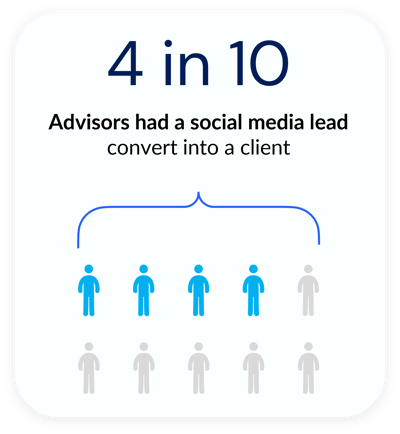The Financial Advisor Marketing Trends Report is a comprehensive study designed to help financial advisors stay ahead of the curve and make informed decisions about their growth marketing strategies.
| 131 financial advisors across Canada | $10M+ in assets under management (AUM) | Fielded October - December 2023 |
Research conducted in partnership with 8 Acre Perspective, an independent marketing research firm hired by Broadridge.
 Strategic marketing is strongly associated with better business outcomes
Strategic marketing is strongly associated with better business outcomesAdvisors who have invested in a defined marketing strategy report more robust results across crucial business areas, yet only one in five advisors have one.

Generate 175% more leads each month

Onboard 69% more clients every year

89% more likely to convert a social media lead into a client

46% more confident in their business growth
 66% of advisors are confident they'll meet practice goals this year
66% of advisors are confident they'll meet practice goals this yearThe financial advisory sector is on the rise due to powerful trends, such as intergenerational wealth transfer, technological advancements, and growing awareness of financial planning. These trends are creating opportunities for advisors to expand their client base and provide tangible value in an evolving and dynamic market.

 44% of advisors are actively focused on acquiring new clients
44% of advisors are actively focused on acquiring new clientsWith the increasing demand for financial advice and services, Canadian advisors recognize the importance of attracting new clients to stay ahead in the market and secure their pipeline.
Although acquiring new clients is a priority for many advisors, it is also important for them to focus on providing quality service to existing clients. By maintaining strong relationships with current clients and delivering high-quality financial advice, advisors can build trust and loyalty, ultimately leading to client retention and referrals.


The financial advice industry is rapidly expanding with demand for planning services and financial products on the rise.
According to the Statista, a global provider of business intelligence and data insights, Assets under Management (AUM) are expected to grow in Canada by a compound annual growth rate of 0.39% between 2024 and 2028, resulting in an expected market volume of $2.65tn by 20281. As younger generations continue to inherit or acquire their own wealth, demand for financial advisory services in Canada will only continue to increase.
This growth may also be attributed to the increasing complexity of financial markets, the growing number of high-net-worth individuals, and the need for personalized financial advice2. The industry is also experiencing a wave of innovation driven by rapid technological advancements, fast-evolving investor needs and behaviours, and an environment of economic stimulus.


The biggest obstacles are:
1. Finding the time
About four in ten advisors spend less than one hour a week on their marketing.
2. Developing a plan
78% of those surveyed find it very or somewhat challenging to define a marketing strategy/plan.
3. Finding the right people
47% of solo advisors use in-house or outsourced marketing staff, however the vast majority are doing it themselves.

 89% of advisors report that finding time for marketing is challenging
89% of advisors report that finding time for marketing is challengingThe vast majority of advisors find it difficult to allocate time to their marketing efforts, spending on average, under two hours (1.7) per week on their marketing.
These findings highlight the challenges and time constraints that advisors face in managing their marketing efforts, prompting consideration of the most efficient use of their time. As the financial advisory landscape continues to evolve, it will be crucial for advisors to find the right balance of time and monetary investment in their marketing strategies to foster lifelong client relationships and grow their practices.

 Advisors spend an average of $7,748/year on marketing
Advisors spend an average of $7,748/year on marketingMost of the advisors surveyed say they expect to maintain their marketing spend over the next 12 months, and another 35% anticipate increasing their budgets.
There are stark contrasts in who prioritizes marketing investments:

 Advisors acquired 15 clients at $531 each on average
Advisors acquired 15 clients at $531 each on averageAdopting proven growth strategies translates into more new clients. Advisors with a defined marketing strategy onboarded 69% more clients in 2023, translating to an average of 22 new clients onboarded. Advisors without a strategy brought in only 13 new clients.

 Advisors are spending evenly on client acquisition and retention
Advisors are spending evenly on client acquisition and retentionAdvisors are allocating more evenly between client acquisition and retention, signaling a shift from the traditional emphasis on acquiring new clients.
This balanced approach underscores a deeper understanding of the long-term benefits that a loyal client base provides. By allocating resources more evenly, advisors can maximize the impact of their marketing efforts to both secure new business and increase AUM from existing relationships.
![marketing allocation [Converted] marketing allocation [Converted]](https://info.advisorstream.com/hs-fs/hubfs/marketing%20allocation%20%5BConverted%5D.png?width=2000&height=875&name=marketing%20allocation%20%5BConverted%5D.png)
 Boomers and Gen-X are the primary targets
Boomers and Gen-X are the primary targetsAdvisors predominantly target their marketing and communications toward Gen X and Boomers because of their accumulated wealth and impending retirements.
Members of these generations are seen as a more lucrative market for retirement planning, wealth management, and estate planning services. Their profitability diminishes as these clients age and transition to the decumulation phase.
Advisors recognize the importance of balancing the immediate need to service profitable clients with investment in younger generations for sustained growth. Advisors report planning to target Millennials and, to a lesser extent, Gen Z, to cultivate future opportunities.


Almost every surveyed advisor (97%) shared that they plan to sustain or increase their marketing spend on social media in the next 12 months.
Referral programs, websites, digital newsletters, and in-person events lagged behind, but still garnered significant investment.

 51% of advisors find their website ineffective at generating leads
51% of advisors find their website ineffective at generating leadsAdvisors report generating an average of 1.6 leads per month from their websites. Moreover, 48% reported no leads from their websites.
However, those who complemented their websites with a defined marketing strategy generated 175% more leads per month from their website compared to those without a defined marketing plan.

 Social media continues to be an important channel for conversions
Social media continues to be an important channel for conversionsAdvisors say that client referrals convert twice as quickly as marketing prospects, and social media continues to be a critical piece of the puzzle. Four in ten advisors say they acquired new clients via their social media connections and networks.
LinkedIn and Facebook have the highest conversion rates. Since LinkedIn caters to a professional audience, it’s a valuable space for advisors to showcase their expertise. On the other hand, Facebook’s more personal nature helps advisors to build rapport and trust with prospective clients.

 LinkedIn remains the top social channel for advisors
LinkedIn remains the top social channel for advisorsSeventy-four percent of advisors invest in LinkedIn as part of their marketing strategies, and 58% invest in Facebook, making those platforms the biggest recipients of advisor marketing dollars.

 It takes ~3.7 months for a marketing prospect to become a client
It takes ~3.7 months for a marketing prospect to become a clientClient referrals come with a built-in foundation of trust and credibility, reducing the time advisors must spend building those relationships from scratch. Unlike typical marketing prospects, client referrals tend to convert much more quickly, requiring just 1.6 months to become a client, on average.
The reality is, the majority of new leads will not be ready to invest on day one. Advisors observe longer lead conversion timelines for those acquired via non-referral channels, amounting to almost four months to convert, on average.
Curating a steady stream of topical, sharable on your social, website, newsletter, and campaign channels can accelerate the trust-building process with leads, potentially shortening the conversion timeline to align more closely with the speed of referral prospects.
![3.7 month [Converted] 3.7 month [Converted]](https://info.advisorstream.com/hs-fs/hubfs/3.7%20month%20%5BConverted%5D.png?width=2000&height=1334&name=3.7%20month%20%5BConverted%5D.png)
 45% of advisors are sharing personalized content
45% of advisors are sharing personalized contentA study by Dow Jones found that 42% of investors felt their advisor could add greater value simply by sharing content and communications personalized to their interests, financial goals, and life events.
Yet only about 4 in 10 advisors actually provide investors with personalized content, indicating a clear opportunity to increase client satisfaction and referrals. Content marketing affords advisors the ability to subtly demonstrate that they understand their clients' goals, and that they're there for every step of the way.
![42% want personalized content [Converted] 42% want personalized content [Converted]](https://info.advisorstream.com/hs-fs/hubfs/42%25%20want%20personalized%20content%20%5BConverted%5D.png?width=2000&height=1568&name=42%25%20want%20personalized%20content%20%5BConverted%5D.png)
 Advisors are not meeting investor expectations on communication frequency
Advisors are not meeting investor expectations on communication frequencyInvestors want advisors to communicate on a weekly cadence, and unfortunately only half of advisors are meeting that frequency. Regular communications, even something as simple as sharing an article, provide investors with tangible value and help position advisors at the top of their clients' inboxes to spark the next conversation.


Investors appreciate a regular cadence of communications from their advisors. In fact, advisors who communicate with investors at least weekly are:


More confident they'll reach their growth goals

And more likely to use personalization in their communications
The potential for AI to streamline processes and further personalize client experiences holds promise, making it a compelling avenue for future innovation.
 56% of advisors use or plan to use AI
56% of advisors use or plan to use AIAI usage is more common among younger and growth-focused advisors eager to incorporate modern productivity tools into their marketing.
Despite lower usage today, 39% of advisors report planning to use AI in the future.


AI has the potential to revolutionize the financial advisory industry by improving efficiency, reducing costs, and enhancing the quality of services provided to clients.
The top ways advisors plan to use AI:
66% generating personalized content
45% personalizing marketing campaigns
52% automating admin tasks and communications
26% segmenting clients or prospects

You don't need to be a professional marketer to turn these insights into action. Simply contact Broadridge, and we'll set you up with a marketing program for success.